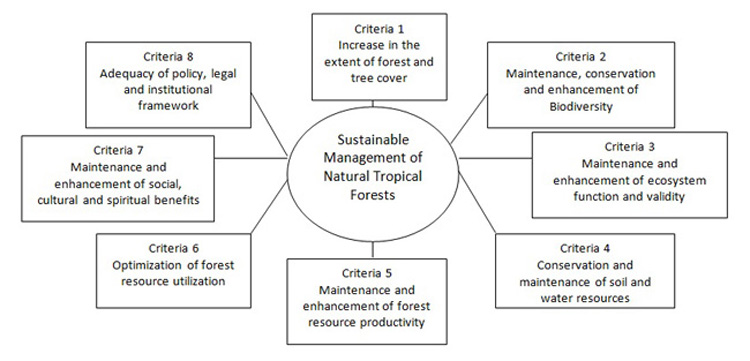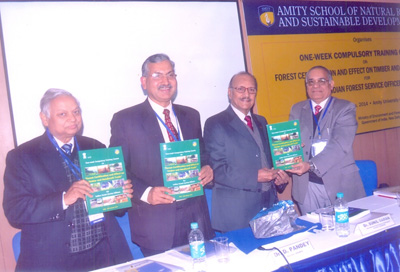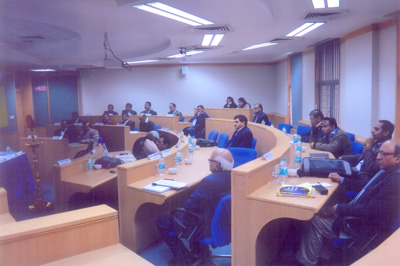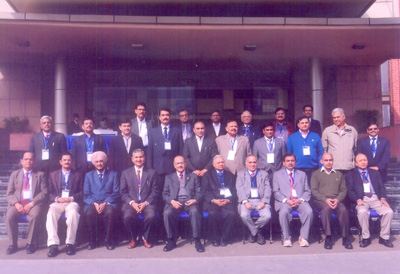One-week Compulsory Training Course for Indian Forest Service (IFS) Officers
On
"Forest Certification and Effect on Timber and Handicraft Trade"
(January 20-24, 2014)
Sustainability has a merged as an important tool for global trade after the Stockholm Conference of World Leaders commonly known as United Nations Conference on Human Environment followed by Earth Summit on Sustainable Development. Global population growth and significant changes in technology, communication and markets have led to dynamic situation. All over the world, stakeholders are asking for “Good Wood” where increased accountability with respect to COC (Chain of Custody) is becoming the norm at State, National and International Level. Meanwhile, forest land and quality of forests have both declined due to over exploitation.
Timber plays a major role in variety of manufacturing activity besides its use for buildings, fuel and other materials most prominent being pulp wood for paper industry. Use of timber wood for local crafts “musical instruments, toys, fixtures to special furniture---artistic and decorative objects” is common within the communities on the fringes of forests.
We are amply aware of the ability of the forests to sequester atmospheric CO2. Premium woods from large and old trees of highly valuable species are scare in most regions. Hence it becomes all the more important that one should aim at harvesting of forest products from sustainably managed forest, in turn leading to medium-term carbon sequestration in the form of wood products. Forest Certification helps to demonstrate that specific forest are being managed in a sustainable manner under a defined set of standards---criteria and indicators---as wood products are harvested. Timber producers having adopted certification process can eventually demand more price premium on their products.
In this context IIFM have developed a set of 8 Criteria and 43 Indicator under Bhopal-India Process and later, joined the dry zone forest initiative of Asia with FAO and other international organizations. So far, India has secured one FSC Forest Management Unit Certificate (644 ha of rubber plantations in Tamil Nadu State) and a few COCs mainly by small and medium companies to meet export demand. Forest management standards are the yardsticks by which the performance of a forest management is assessed for certification purposes. There are a number of standards already existing but standards for criteria 2 and 6 have not been developed.
In brief, Schematic tabulation of criteria is presented below:

18 Senior Indian Forest Service (IFS) Officers from 14 States/Union Territories across the country had attended this training course. There was very good interaction with renowned resource persons during the technical sessions. From the review of feedback forms our school has secured an overall rating of 89 per cent.
Based on the feedback received we shall endeavor for:
- Some more such courses to be organized by the Ministry of Environment and Forests at our university campus for the benefit of IFS officer fraternity.
- Presence of senior officers of MoEF to share views of the Government of India with regard to FSC.
- Discussion on case studies from developed and developing countries especially European and Latin American Countries to be deliberated.
- Forest Development Corporations (FDCs) as well as Medicinal Plants Boards (MPBs) should be given a special thrust by the Ministry of Environment and Forests (MoEF). It will be desirable to have meetings of Managing Directors of Forest Development Corporation at regular intervals at MoEF level aiming at:
- To search for areas of cooperation at national and international level for creating and expanding market for produce from sustainably managed forests and plantations. Initially all the PSUs buying wood can be brought in the net with initiative from MoEF.
- To provide directions and a platform for dialogue and for developing a common vision for all the major stakeholders of forest produce.
- To discover new markets of forest produce.
- Ministry should rigorously pursue the cause of certification and issue guidelines for indicators and their discussions in such workshops/programs. The institution of working plans, and its allied documents like control forms, compartment history and other information should be distilled to be used for sustainability indicators.
- Currently BSI Certification is only for timber. Same needs to be expended for other forest products also.
- On the lines of Railway Safety Commission (RSC) MoEF should also create an autonomous agency for granting forest certification in the country.
- Need for independent certification of forest ecosystem.
- Make more certifying units available for identification of wood used in handicrafts and other products for safe guarding the interest of artisans, tree growers and for other forest based industries.
- Regular training for capacity building of tree growers, artisans and traders should be arranged by MoEF to raise awareness and to create demand for sustainable forest produce.
- Ministry of Industries and Trade should be requested by MoEF to have an incentive scheme for tree growers and for forest based industries to induce them for products from sustainably managed forests and tree plantations.
- In view of changed focus of forest policy from regulatory to participator and from timber centric and eco-centric, the forest management and its forest governance needs to be relooked from sustainability angle.
PHOTOGRAPH
 |
 |
| Lighting of Lamp | Release of study material |
 |
 |
| A view of participants | Class in session |
 |
|
| Group Photograph of participants with Advisor, Prof. B.K.P. Sinha |